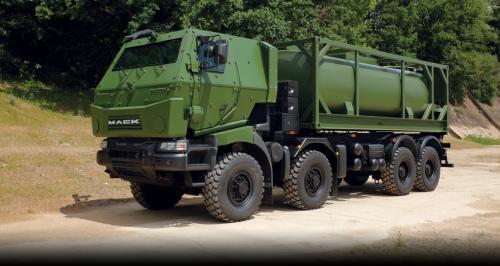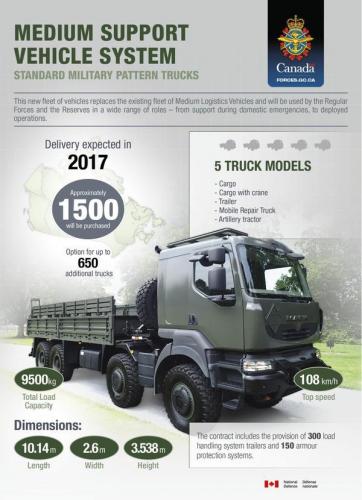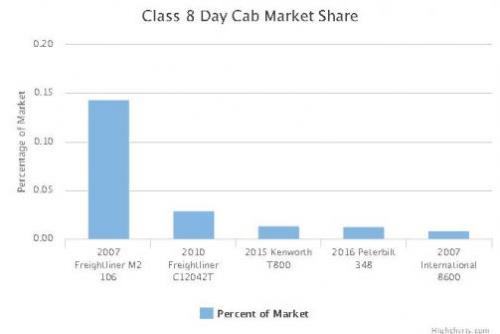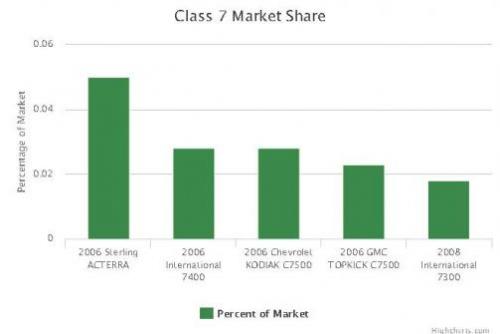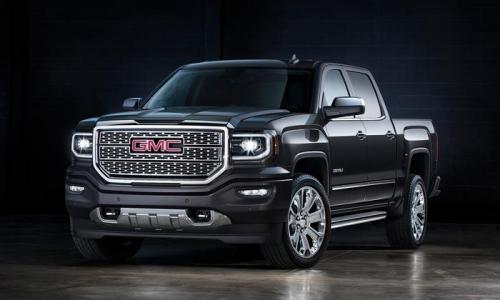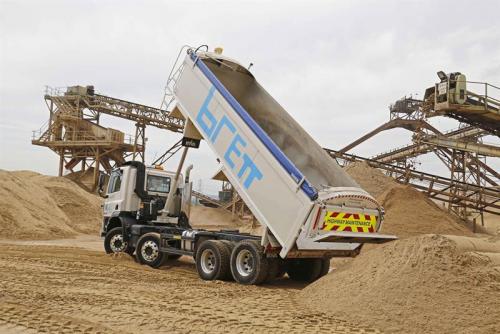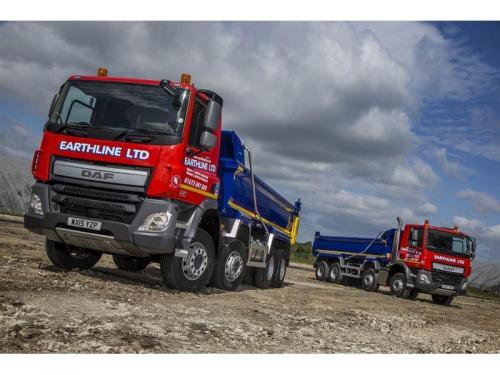
kscarbel2
Moderator-
Posts
18,540 -
Joined
-
Days Won
112
Content Type
Profiles
Forums
Gallery
Events
Blogs
BMT Wiki
Collections
Store
Everything posted by kscarbel2
-
Trailer/Body Builders / July 16, 2015 Mack Defense has been awarded two contracts by the Department of Public Works and Government Services Canada on behalf of the Department of National Defense to deliver more than 1,500 [re-badged Renault Kerax] 8x8 trucks for the Medium Support Vehicle System (MSVS) Standard Military Pattern (SMP) program and to provide an initial five years of In-Service Support (ISS) for the SMP fleet operating in Canada and throughout the world. Mack Defense (www.mackdefense.com) will also provide 300 trailers and 150 Armor Protection Systems as part of the two contracts valued at $561 million. Deliveries will begin in the summer of 2017 with completion in the fall of 2018. “We are extremely proud that the Canadian government has chosen Mack Defense to provide the Canadian Armed Forces with our MSVS SMP solution,” said Ryan Werling, president of Mack Defense. “Mack has supplied the Canadian Armed Forces with trucks since World War II and we are honored to continue to support Canada’s domestic and international missions for years to come.” The vehicle systems will include multiple variants such as cargo, material handling cranes, load handling systems (LHS), and mobile repair trucks (MRT). Mack Defense will work with key strategic Canadian partners including Volvo Group sister company Prevost; Dumur Industries Ltd; EODC, Inc.; and Link Suspensions of Canada (Raydan Division). System assembly will take place in Prevost’s Sainte-Claire, Quebec, plant. The Volvo Group’s global supply chain, with a strong presence across Canada and in 42 other countries worldwide, serves as the foundation of the In-Service Support program. Related Reading - http://www.renault-trucks-defense.eu/Defense/KERAX/RIGID .
-
EPA accuses Navistar of Clean Air Act Violations With Big Diesels
kscarbel2 replied to kscarbel2's topic in Trucking News
EPA Suing Navistar Over 2010 Engines Transport Topics / July 16, 2015 The U.S. Environmental Protection Agency on July 14 filed a lawsuit against truck maker Navistar International Corp. alleging that the company in 2009 began the manufacture of 7,750 heavy-duty diesel engines it offered for sale in calendar year 2010 that did not meet emissions standards applicable to 2010 engines. “None of the subject engines were covered by a certificate of conformity [nor exempt from the prohibition against selling, offering for sale, introducing or delivering for introduction into commerce engines not covered by a COC] when they were sold, offered for sale, introduced or delivered for introduction into commerce by defendants,” the EPA said. “Additionally, each and every delegated assembly engine was ‘fully assembled, except for aftertreatment devices’ in 2010 and is therefore not a model-year 2009 engine.” A certificate of conformity verifies that a heavy-duty diesel engine meets EPA’s standards limiting the emission of oxides of nitrogen and non-methane hydrocarbons. Navistar could face penalties of up to $37,500 per day for each violation of the Clean Air Act. “We dispute these allegations,” Navistar spokesman Steve Schrier told Transport Topics. “We believe our 2010 engine transition was appropriate, and we intend to aggressively defend our position going forward.” In its complaint, EPA said that on Nov. 3, 2010, the EPA sent Navistar a request “seeking certain information as part of an EPA investigation into Navistar’s compliance with the emissions standards.” “EPA generally sought information from Navistar relating to the names, build dates, model years, vehicle information numbers, serial numbers, engine classes, dates of installation and assembly, and other information related to engine and vehicle manufacturing operations of Navistar,” the lawsuit said. On Feb. 4, 2011, Navistar provided an initial response to EPA claiming the information being sought was confidential. The EPA said it has determined that some, but not all, of the information submitted to the agency in a spreadsheet deserves “confidential treatment.” -
Transport Topics / July 16, 2015 Less-than-truckload carrier Con-way Freight is purchasing 875 new trucks to update its fleet of linehaul and pickup/delivery vehicles. In a July 16 statement, the LTL carrier, the largest subsidiary of Con-way Inc., said the vehicles are made by the Freightliner division of Daimler Trucks North America. Con-way ranks No. 4 on the Transport Topics Top 100 list of U.S. and Canadian for-hire carriers. Ann Arbor, Michigan-based Con-way said it will take possession of the trucks this year. Of the total, 450 will be Class 8 Cascadias for linehaul work and the rest will be Class 7 M2s for pickup and delivery. The carrier also is buying 1,750 new trailers made by Con-way Manufacturing, formerly Road Systems, another unit of Con-way Inc. “The new power units will provide greater fuel efficiency, as they are designed with better emission controls and features,” said Tim Killilee, senior director of maintenance at Con-way Freight. “Most importantly, we have listened to our drivers and incorporated their feedback in the process, including features they’ve identified as being critical,” Killilee said. The Cascadias will have automated manual transmissions, and the M2s will have fully automatic transmissions. The company said managers made that choice because “without the need to operate a clutch and manually shift through the gears, drivers are able to place additional focus on traffic and road conditions as well as proactive defensive-driving techniques. ” The linehaul tractors also will have forward-looking, adaptive radar for front-collision avoidance, lane departure warning and rollover-stability control systems. The parent company also owns a major carrier, Con-way Truckload.
-
Prime Mover Magazine / July 16, 2015 In preparation for the commercial launch of the International ProStar in early 2016, Navistar Auspac said the new model is currently undergoing a “detailed component analysis” to ensure a smooth roll-out. In a media statement released yesterday, the company said the launch at the Brisbane Truck Show was but one of many steps in the process of rebuilding International’s presence. “From here on a major focus is confirming ProStar’s engineering credentials for this market before it goes on sale early next year,” said says Glen Sharman, Director of Sales, Marketing and Business Development at Navistar’s Australia/Pacific division, Navistar Auspac. “This is certainly no quick ‘tick the box’ exercise,” said Navistar Auspac Chief Engineer Adrian Wright (pictured). “Between now and ProStar’s commercial availability next year, every component and assembly will be assessed, evaluated and ultimately validated for Australian conditions.” He added, “At the same time we’ll be verifying the aerodynamics and fuel efficiency which are such big assets for ProStar in the US. So while dealership and service structures continue to be negotiated and developed, engineering appraisal and on-road testing of ProStar is now running at full throttle.” While Australia may be a relatively low volume market in the global context, Navistar engineering executives are well aware of this market’s highly competitive and often demanding character. Consequently, Navistar engineering teams have adopted a ‘high volume’ approach which effectively works to avoid small problems becoming big issues on high volume production lines, said Wright. “For a major manufacturer like Navistar, a small issue can have dramatic flow-on effects for the company and worse, its customers,” explains Adrian Wright. “This exercise is all about avoiding those issues.” Wrigth said there were “hundreds of components” under evaluation still, with well over 2200 parts and assemblies making up the bulk of the right-hand-drive ProStar’s ‘bill of materials’.
-
Fleet Owner / July 16, 2015 C.R. England has introduced 2016 Western Star 5700 XE tractors into its fleet, the company announced. Starting in July and then over the next several months, almost 200 new units will be put into service in the C.R. England fleet, with tenured solo and team drivers and million miler drivers the first to receive the Western Star vehicles, the company said. Tenured independent contractors with lease availability will also be offered the option on new units. "The adaptive cruise is so innovative and makes it easier to focus on being safe," said Zach England, chief operating officer, after a recent trip driving one of the vehicles. "We are pleased with this new addition to our fleet and expect it to be quite popular with our drivers." The tractors feature woodgrain and leather interiors and a Detroit Powertrain, which the company said combines the DD15 with the direct drive DT12 automated shift transmission. In addition, these trucks come with safety features including forward collision mitigation, adaptive cruise, and hill-start technologies. The Western Star 5700 XE has been designed to increase efficiency and to reduce the total cost of ownership, the company said. "Over the course of the last 12 months, we've been working with our valued partners at Warner Truck Center and Western Star Corporate to procure these state of the art tractors," said Brandon Harrison, co-chief operating officer. "We're thrilled to be in a position to offer our professional driver force some of the best and safest equipment on the market."
-
House amendment would exempt glider kits from EPA proposal
kscarbel2 replied to kscarbel2's topic in Trucking News
Glider Kit Amendment Stalls with House Bill Heavy Duty Trucking / July 16, 2016 An amendment limiting the EPA’s ability to regulate glider kits under Phase 2 greenhouse-gas and fuel-economy rules has stalled in the U.S. House of Representatives, as its underlying bill was pulled from further consideration by House leaders because of an unrelated controversy. The amendment was offered by Congresswoman Diane Black (R-Tenn.) in response to concerns by constituents who assemble and sell glider-kitted trucks, and some fleets that buy and use them, reports the American Truck Dealers and its parent, the National Automobile Dealers Association. The amendment to House Resolution 2822, an appropriations bill funding the Environmental Protection Agency and other government operations, passed by voice vote on July 8. However, the bill became snarled in the controversy over the Confederate flag, and it now appears unlikely to pass in this session, making the amendment’s fate uncertain, says ATD-NADA. Under the amendment, EPA couldn’t use appropriated funds during fiscal year 2016 to require most gliders to use diesel that meet current exhaust emissions limits. That is one of the many provisions in the proposed Phase 2 standards requiring better fuel economy and lower emissions beginning with model-year 2018. -
Senate Panel Reverses Course on Rentals of Recalled Vehicles Bloomberg / July 16, 2015 A Senate panel killed a proposal to permit companies to continue renting vehicles that have been recalled, a measure criticized by consumer groups, automakers and even some rental-car companies. The Commerce, Science and Transportation Committee instead voted Wednesday to require cars be repaired before they’re rented. The change resulted from an amendment by Senator Claire McCaskill, a Missouri Democrat. It modified a bill, introduced last week by Senator John Thune, a South Dakota Republican, that would have allowed rentals with known safety defects as long as companies disclosed the open recalls to customers. “When consumers and families drive a rental car off the lot, they should be able to do so with the confidence that car is safe to drive, and we’re one step closer to that peace of mind today,” McCaskill said. The panel approved the overall bill, which sets policy for automotive, trucking and rail regulators, on a party-line 13-11 vote. Democrats objected to the measure, saying it failed to include needed auto-safety provisions. In the past week, Honda Motor Co. joined General Motors Co. as the second automaker to back the Democrats’ push for a ban on rentals with safety defects. Consumer Protection The American Car Rental Association, a trade group that includes Hertz Global Holdings Inc., Avis Budget Group Inc. and Enterprise Holdings, described the original Republican bill as a “significant step back in consumer protection” compared with current industry practices in a July 13 letter to committee leaders. The National Automobile Dealers Association and the Alliance of Automobile Manufacturers aired objections about the Democrats’ proposal, saying it would have the unintended effect of harming consumers because dealerships would be forced to repair rental cars before their customers’ vehicles. Thune said the overall bill would increase funding for National Highway Traffic Safety Administration investigations and double civil penalties for automakers to $70 million. Those changes would be directly tied to the agency adopting changes recommended by Transportation Department inspector general, he said. “The bill before us today makes a host of important improvements when it comes to motor vehicle safety,” Thune said. Jail Time Democrats introduced an amendment that failed on a party-line vote to give NHTSA more funding and allow jail time for executives who hide auto-safety defects. Some critics said the legislation failed to reflect safety lessons learned from faulty ignition switches in General Motors Co. vehicles and Takata Corp. air bags that exploded and killed motorists. “This is a tragic and neglectful assault on consumer rights in favor of the auto and trucking industries,” said Senator Richard Blumenthal, a Connecticut Democrat. “Sadly, the majority failed to learn the lessons of the GM ignition-switch cover up and Takata’s exploding air bags.” The legislation approved by the panel would force the Federal Motor Carrier Safety Administration to overhaul one of its primary enforcement tools, a publicly available listing of safety violations of trucking and bus companies, which compares individual firms with industry averages. The agency would have to remove scores from public view while it responds to critiques from the Government Accountability Office and the Transportation Department’s inspector general. That change has been backed by the trucking industry. For railroads, the measure would allow the Transportation Department to adjust deadlines for implementing crash-avoiding train technology on a case-by-case basis. Thune said the action was needed because few railroads were going to make the existing 2015 deadline. Installations would be delayed to no later than 2018.
-
The New Ford Everest: Engineered for Extraordinary Ford Press Release / July 15, 2015 The new Ford Everest is exceptionally versatile, equally at home in busy urban traffic and the most extreme off-road terrain. A bold exterior and spacious, modern interior complement advanced technologies that make it one of the smartest SUVs in its segment. Related reading: http://www.bigmacktrucks.com/index.php?/topic/39398-2015-ford-everest-global-debut/?hl=everest http://www.bigmacktrucks.com/index.php?/topic/39373-ford-everest-taming-the-terrain/?hl=everest http://www.bigmacktrucks.com/index.php?/topic/37730-ford-introduces-all-new-mid-size-everest-suv/?hl=everest .
-
Automotive News / July 16, 2015 Ford Motor Co. has begun offering discounts that can exceed $10,000 on its new aluminum-bodied F-150 pickup, which has been losing sales and market share this year as the automaker works to build inventory on dealer lots. The company's website offers "up to $10,029 in total savings" on a 2015 F-150 XLT SuperCab 4X4 with the luxury chrome or sport package in some U.S. regions. That model comes with a discount of $7,050 in other areas, according to Ford.com. U.S. sales slid 8.9 percent last month for Ford's F-Series pickups, its top-selling line and most profitable vehicles. The truck's share of the big pickup market fell to 28 percent in June from 33 percent a year earlier, according to Autodata Corp. Ford blamed tight inventory caused by the conversion of two plants to build the trucks, the first mass-market vehicles to use lightweight aluminum so extensively. “The truck hasn’t sold up to expectations for the most part,” said Akshay Anand, an analyst at auto researcher Kelley Blue Book. “This may be a hint that in certain parts of the country, the issue might just be more than supply.” Improving inventory of F-150 is allowing Ford to offer more competitive incentives as part of its Summer Sales Event promotion, Erich Merkle, the company’s sales analyst, said Wednesday. He said overall incentive spending is down from a year ago and that the truck is selling for $44,100 on average, the highest transaction price in the segment. “What will be more telling is whether the incentives start to go out nationwide,” Kelley Blue Book’s Anand said. “If limited to higher end trims and packages, this may not have a huge effect for the moment, as a truck still makes plenty of profit.” Ford cut spending on marketing promotions per vehicle 16 percent in this year's first half to an average $2,736, according to Autodata, which found smaller increases by General Motors Co. to $3,427 and Fiat Chrysler Automobiles NV to $3,277. Some dealers began advertising discounts of $10,000 to $11,000 off the new F-150 in June, Automotive News reported on July 1. Asked about the dealer ads touting $10,000 discounts on F-150, Ford's top U.S. sales executive said the incentives were being offered by individual dealers. "I can tell you that that number of $10,000 is commonly used by our competition," said Mark LaNeve, vice president of U.S. marketing, sales and service. "So you've probably seen a competitive response by a given individual dealer." Sales of GM's Chevrolet Silverado truck jumped 18 percent last month, as its share of the full-size pickup market grew two points to 25.9 percent. Sales rose 0.6 percent for Fiat Chrysler's Ram pickup and gained 4.3 percent in the first half.
-
Bloomberg / July 15, 2015 Former U.S. Transportation Secretary Ray LaHood discusses the state of America’s infrastructure as the lack of funding for transportation. Video - http://www.bloomberg.com/news/videos/2015-07-15/america-is-one-big-pothole-ray-lahood
-
Truck News / July 15, 2015 Ontario-Canada-based Titanium Group has announced it’s adding 240 new Volvo VNL 670 trucks to its fleet. The first shipments have already arrived, with the company scheduled to take delivery of 140 this year and in early 2016. Titanium has also secured build slots for an additional 100 trucks scheduled for delivery next year, the company announced. “The increase in the size of our fleet is a direct response to our customers needs in our core markets where access to freight capacity has become limited,” announced Ted Daniel, Titanium Group CEO. The company currently operates 350 power units, including 30 Volvo trucks that have already been delivered in 2015.. A portion of the new trucks will be used to replace equipment obtained through future acquisitions and some will replace existing power units. The trucks will be financed through Volvo Financial Services, the company announced.
-
Senator Booker proposes truckers carry more insurance; paid hourly
kscarbel2 replied to kscarbel2's topic in Trucking News
New bill mandates driver duty-time pay, doubles insurance minimum Fleet Owner / July 13, 2015 Just a couple of days after raising a ruckus about truck safety in a Senate subcommittee hearing, and about year after trying to block the hours-of-service restart rollback on the Senate floor, Sen. Cory Booker (D-NJ) has introduced legislation containing a list of items “to modernize truck safety standards,” ranging from equipment mandates to operations management. According to the summary and commentary provided by Booker’s office, the Truck Safety Act (S. 1739) provisions address: Minimum insurance. Increases the minimum levels of insurance trucks must carry from $750,000 to $1.5 million. Insurance minimums have not been raised since the 1980’s and the current amounts do not provide adequate compensation for victims. The bill also increases insurance levels to keep pace with inflation, and gives the Secretary of Transportation discretion to raise minimum levels if deemed necessary. Collision Avoidance Systems. Requires a rulemaking for commercial motor vehicles to have crash avoidance systems, such as forward collision warning systems and lane departure warning systems. The National Transportation Safety Board found that these advanced systems are critical to preventing rear-end collisions, thus saving lives and reducing injuries. Speed Limiting Devices. Requires the Secretary of Transportation to finalize regulations requiring commercial motor vehicles to have speed limiting devices to prevent speeding. Safety advocates have estimated that the rule could prevent more than 1,000 fatal crashes. Driver Compensation. Requires the Secretary of Transportation to mandate that employers compensate truck drivers for hours worked. Unfortunately, standard industry practice is for truck drivers to be paid based on miles driven and not hours worked, causing truckers to be overworked which creates perilous safety conditions on the nation’s roads. Excessive Commuting. Would require a study on the effects of excessive commuting. There are concerns that far too often, truck drivers commute several hours to and from their base of operation, only adding to the grueling schedules many of them already work. “Truck drivers work extremely long days to deliver the goods we depend on and keep our economy moving, but too often this comes at the expense of their safety and the safety of other drivers,” Booker said in statement. “We can significantly reduce the number of accidents on our nation’s highways by harnessing new technologies, and better protect victims of truck accidents by raising insurance minimums for trucks that haven’t changed in over 30 years. The Truck Safety Act will protect all drivers and make our nation’s highways safer.” Booker is the top Democrat on the Commerce committee’s transportation subcommittee, which has jurisdiction over truck safety. The full committee is scheduled to meet Wednesday on the Senate’s proposed highway bill, a six-year program that contains a number of trucking-related provisions. -
Fleet Owner / July 15, 2015 In its formal report regarding the investigation of a horrific truck-motorcoach collision last year that killed 10 people outside Orland, CA, the National Transportation Safety Board (NTSB) is again recommending that event data recorders (EDRs) be installed on commercial vehicles. “With access to event data recorders, we might have been able to determine why the truck crossed the median, which could have enabled us to make recommendations to prevent it from happening again,” NTSB Chairman Christopher Hart in his remarks at agency’s crash briefing yesterday. “Much of the reason that aviation is so safe today is that we have required such recorders for decades so that we can learn the lessons of accidents,” he added. “But they are still not required in commercial trucks or motorcoaches despite more than a decade of recommendations by the NTSB.” Mark Rosenker, who served as NTSB chairman from 2005 to 2009, stressed a similar point during a presentation at the 2015 ALK Transportation Technology Summit back in May. “Accidents never involve only one thing; they are a chain of events that come together for a catastrophic result,” he explained. “Thus the NTSB’s mission is to establish what happened, how it happened, determine the probable cause, and make sure it never happens again. And that’s where data can make a really big difference.” In the Orland crash that occurred on April 10, 2014, NTSB determined that a 2007 Volvo truck-tractor operated by FedEx Freight crossed a 58-foot-wide median, struck a 2013 Nissan Altima four-door passenger car, and then collided head-on with a 2014 Setra motorcoach. Both the truck and the motorcoach drivers were killed, along with eight motorcoach passengers, while 37 motorcoach passengers and two occupants of the passenger car sustained injuries. NTSB said its Investigators were unable to determine why the truck crossed the median, but they ruled out both truck and motorcoach driver inexperience, licensing and training, as well as alcohol and drug use, mechanical factors, and weather as causes of the crash. Likewise, the agency said it found no evidence that the truck driver suffered from distraction, fatigue, or that he intentionally crossed into opposing traffic. Along with its renewed call for mandatory EDRs on trucks and motorcoaches, NTSB offered several other recommendations: That motorcoach interiors be designed with improved flammability requirements;That current motorcoach safety standards lack adequate requirements for emergency lighting and signage and should be beefed up to require independently powered lighting fixtures, use of photo luminescent material to mark emergency exits, and windows that remain open after being opened for emergency evacuations;That motorcoach companies provide a pre-trip safety briefing or video concerned safety and evacuation procedures;That a secondary door be installed on motorcoaches for use as an emergency exit to expedite evacuations and reduce the potential for injuries caused by jumping from window exits.
-
Fleet Owner / July 15, 2015 According to data collected by Equipment Watch Intelligence, Freightliner holds the top two spots for day cab tractors in the Class 8 market. However, 2012 models dominated the Class 8 sleeper market. Based on 26,650 monthly sales records that power Truck Blue Book, the top five heavy-duty models on the commercial truck resale market for June 2015 – for Class 8 day cab tractors, Class 8 sleep tractors, and Class 7 – are: Class 8 day cab tractors: 2007 Freightliner M2 106 2010 Freightliner C12042T 2015 Kenworth T800 2016 Peterbilt 348 2007 International 8600 Class 8 sleep tractors: 2012 International ProStar 2012 Freightliner CA-125-SLP 2012 Kenworth T700 2012 Kenworth T800 2012 Volvo VNL-64-T-670 Class 7: 2006 Sterling Acterra 2006 International 7400 2006 Chevrolet KODIAK C7500 2006 GMC TOPKICK C7500 2008 International 7300 .
-
Article - http://blog.caranddriver.com/rule-the-beach-with-this-classic-off-roader/ Picture gallery - http://www.caranddriver.com/photo-gallery/rule-the-beach-with-this-classic-off-roader#1
-
- 1
-

-
EPA accuses Navistar of Clean Air Act Violations With Big Diesels
kscarbel2 replied to kscarbel2's topic in Trucking News
Please remember, the arrogant Ustian aside, the Massive EGR (MEGR) system used by Navistar was designed and funded by the EPA (with your tax dollars). Your EPA decided that MEGR (EGR levels from 35% to 50%) was the optimum technology, but they needed at least one truckmaker to run with their ball........and a politically correct Ustian agreed to do it (because the EPA was paying most of the tab). -
Automotive News / July 15, 2015 GMC is refreshing its Sierra pickup for the 2016 model year with a redesigned front end in a bid to keep the sales momentum going for one of General Motors' most profitable vehicles. A video posted on GMC's YouTube site shows the 2016 truck equipped with C-shaped LED daytime running lights, new LED fog lamps and tail lamps, and new bumpers. Each trim level of the truck also will get its own grille design for 2016. A GMC spokesman said more information would be available about the '16 model closer to its on-sale date, sometime in the fourth quarter. The Sierra's sister vehicle, the Chevrolet Silverado, also is getting a refresh for 2016, GM said this week. Both trucks have been on a sales roll in the U.S. despite some gripes from some dealers and analysts about ho-hum styling when they were launched two years ago. U.S. sales of the Sierra jumped 8.2 percent through the first six months of the year. Silverado sales increased 15 percent. Overall, deliveries of large pickups have increased 4.7 percent across the industry this year through June. GM's share of the U.S. large pickup market has increased to 37.2 percent this year from 34.5 percent through June 2014. The updates to GM's big pickups follow the launch of Ford Motor Co.'s redesigned F-150 pickup for 2015. And Nissan Motor Co.'s overhauled Titan pickup will go on sale later this year. Video - https://www.youtube.com/watch?v=ajZBRoNNNG4 .
-
I never cared for the man, as he always displayed an arrogant demeanor.
-
Bloomberg / July 16, 2015 Navistar Inc. was sued by the U.S. Justice Department for alleged violations of the Clean Air Act over the 2010 sale of heavy-duty diesel engines that didn’t meet the Environmental Protection Agency’s emissions standards. The suit, filed Tuesday, seeks civil penalties of as much as $37,500 a day for each violation, according to a company filing with regulators. Lisle, Illinois-based Navistar said it disputes the allegations, which are related to about 7,750 heavy-duty diesel engines.
-
Scania Press Release / July 14, 2015 Scania’s market share in Europe reached a record high 17.2 percent during the first half of 2015. The increase was attributed to the early and highly successful introduction of its Euro 6 truck range, and sales activities in new segments. Scania increased its market share in the European truck market to 17.2 percent during the period January to June 2015, compared to 15.3 percent during the same period of 2014. The positive trend which began last year with the transition to the Euro 6 emission standard (comparable to EPA2010) thus continued. “The feedback from our customers shows that we have really met the high expectations placed on our Euro 6 engine range and that demand in our major European markets is good,” says Scania’s President and CEO Per Hallberg. The second and third generation Euro 6 engines from Scania have proved to perform very well at customers and in trade press tests. Increased sales activities in new segments have also contributed to the record high market share in Europe. Order bookings in Europe increased by 41 percent to 13,270 (9,410) Scania trucks, compared to the second quarter of 2014. Meanwhile, demand continues to be weak in Brazil and in Russia. “In Brazil, order bookings were impacted by the low economic activity and less favourable conditions for truck purchase subsidies. Russia was also affected by low activity,” explains Hallberg. Order bookings in Latin America decreased by 34 percent to 2,611 (3,960) units during the second quarter compared to the same period of 2014. Eurasia, where Russia is the main market, order bookings decreased by 4 percent to 731 (760) units. Scania’s total order bookings amounted to 19,823 (20,987) trucks during the second quarter of 2015. Scania is one of the world’s leading manufacturers of trucks and buses for heavy transport applications, and of industrial and marine engines. Service-related products account for a growing proportion of the company’s operations, assuring Scania customers of cost-effective transport solutions and maximum uptime. Scania also offers financial services. Employing some 42,000 people, the company operates in about 100 countries. Research and development activities are concentrated in Sweden, while production takes place in Europe and South America, with facilities for global interchange of both components and complete vehicles. In 2014, net sales totalled SEK 92.1 billion and net income amounted to SEK 6 billion. Related reading - http://www.bigmacktrucks.com/index.php?/topic/35958-scania-launches-new-450hp-engine-with-scr-only/?hl=scania
-
Teen truckers? Bill would lower interstate truck driver age to 18
kscarbel2 replied to kscarbel2's topic in Trucking News
18-year-old truck drivers: Lack of decent wages cause worker shortages The Seattle Times / July 14, 2015 The story on the move to allow 18-year-olds to get licenses to drive big-rig trucks gives the game away when it says, “The driver shortage could be eliminated by raising truckers’ wages and improving working conditions” [“18-year-olds as truckers drives up safety fears,” Page One, July 11]. There are likely millions of men and women out there who would love to drive trucks if they thought they could make a decent living. But in this Internet age, it is easy to find out how hard it is to find a family-wage job that has some job security. So we have a shortage of truck drivers. This shortage mirrors the shortage of workers in other industries. In each case decent wages, job security, or both are missing. And in each case, the industry in question responds not by improving wages or job security but by trying to tap into a heretofore underutilized pool of low-wage replacements. In short, anything to keep wages low and employees, or rather “contractors” in many cases, pliable. Wages have been stagnant for three decades now. Benefits, including health care, vacation, and access to a good retirement system, have been slashed. -
Transport Engineer / July 14, 2015 Brett Aggregates’ latest DAF 8x4 CF tipper, which has a PPG insulated alloy body, was retrofitted with Hyva’s new lightweight FCA129 tipping cylinder (in place of its standard FC137), as launched at the recent TIP-Ex show in Harrogate. The result, according to the Faversham, Kent, based aggregates company's transport manager Tom Clubb is an unladen weight of just 11,900kg – meaning a full 20 tonnes payload capacity. Accordingly, Brett has ordered another 10 new tippers to the same specification, which are due for delivery in September. "At 430kg, this new Hyva ram is 20kg lighter than anything else," enthuses Clubb, who is responsible for the firm's 80-plus tipper fleet. "While 20kg doesn't sound a lot, the real issue is there's no point in us carrying around unnecessary deadweight," he continues. "What I also like about the FCA129 is that Hyva has really given the issue of tipping gear design a significant new direction - and not just on weight." And he points to the equipment's separate ram and tank design – meaning that the oil tank no longer needs to be fabricated from steel. "Hyva's use of industrial quality plastic for their oil tank saves both weight and cost," he explains, adding that maintenance on the cylinders is "much easier", so reducing downtime costs. Brett Aggregates' latest tippers are all fully compliant to the CLOCS standard and accredited to FORS. They are also fitted with the Exeros 360 degree camera system – as well as cameras inside the body to assist the driver in ensuring correct loading and tipping – plus Navman telematics to monitor critical areas of vehicle and driver performance. "We encourage our drivers to be as involved as possible," states Clubb, "and to see themselves as 'asset managers' where their professionalism and expertise can really make a difference." For him that means not just monitoring fuel consumption, but taking "a much wider view that embraces and encourages better driving practices" to improve safety and reduce maintenance costs. And talking of asset management, Clubb further asserts that managing tipper downtime is also key – and that Hyva performs well in that regard. "Recently, we needed a replacement cylinder for both a Hyva ram and an existing combined ram and tank hoist," he recalls. "I spoke to Hyva on a Friday afternoon and we had the cylinder the following morning - a Saturday," he continues. "Without the complication of an integral oil tank, the cylinder was also quick and easy to fit. In complete contrast, a replacement cylinder for our previous fleet standard combined ram and tank model would take six weeks." .
-
Transport Engineer / July 15, 2015 Bulk excavation and aggregates operator Earthline has taken delivery of four Euro 6 DAF CF trucks, moving back to the marque following the opening of a new dealership nearby. Dealer Imperial Commercials opened a £2.74m fully-equipped facility in Dorcan, Swindon, earlier this year and this influenced Marlborough-based Earthline's decision to buy the CF 400 FAD eight-wheel tippers, says general manager Malachi Chambers. "We've always rated the DAF product very highly. We did feel, however, that DAF required a stronger presence in the area, and that investment was needed in a local, modern DAF location that offered sales, service and parts... We're delighted to be back with DAF." Earthline's new 'muck-away' DAF eight-wheelers are equipped with straight beam front axles to provide high ground clearance and approach angle. The trucks have Predator Ultimate bodies from ABBA Commercials and Hyva tipping gear, and have been specified to Crossrail standards. Imperial Commercials supplied the vehicles with four-year DAF MultiSupport R&M contracts. .
-
July 10, 2015 Truckers would have to carry more insurance and be paid by hours worked rather than miles traveled under legislation introduced Friday by U.S. Senator Cory Booker. The Truck Safety Act also would require the government to develop new rules requiring commercial vehicles to have systems to help avoid collisions and to limit their speeds. "Truck drivers work extremely long days to deliver the goods we depend on and keep our economy moving, but too often this comes at the expense of their safety and the safety of other drivers," said Booker (D-N.J.), the top Democrat on the Senate Commerce surface transportation subcommittee. The American Trucking Associations, the trade group for the trucking industry, applauded some elements of the legislation and objected to others. A fatal crash in June 2014 on the New Jersey Turnpike involving actor and comedian Tracy Morgan has called attention to the issue of truck safety. Morgan was injured and comedian James "Jimmy Mack" McNair was killed when their limousine was rammed from behind by a Wal-Mart tractor-trailer truck. The driver of the truck, Kevin Roper, had not slept for more than 24 hours, State Police said. Booker in December unsuccessfully tried to block a provision to suspend two rest rules for truck drivers until Sept. 30 or whenever the government completes a study of the impact of those regulations, which were designed to limit when truckers can take an extended break between trips. Under the senator's new legislation, trucks must carry at least $1.5 million in insurance, up from $750,000 limit that has not been raised in three decades. Future levels would rise with inflation. It would require that truck drivers be paid for hours they work, not for the miles they drive. The transportation secretary would be instructed to issue those rules. The bill also would require new rules to require the installation of devices that would help curb rear-end collisions and prevent trucks from speeding, and study of the impact of truck drivers having to commute several hours before they begin their routes. Rob Abbott, vice president of safety policy for the American Trucking Associations, said the group supports the speed limit devices, which are already been considered by the Transportation Department, and has backed other technologies proven to avoid collisions. "We support mandates for devices that have proven safety benefits," he said. He also supported Booker's call for studying the impact of long commutes on drivers. "Solutions to driver fatigue can't be focused solely on the hours they work," he said. As for the insurance provision, Abbott said there is no evidence showing the need to raise the minimums, and the current levels cover most accidents when the driver is responsible.
-
Associated Press / July 10, 2015 Parents may hesitate to hand teens the keys to the family car, but Congress is proposing to allow drivers as young as 18 to get behind the wheel of big rigs on the nation's interstates. Federal regulations currently require drivers be at least 21 before they can drive commercial trucks across state lines, but a bill introduced this week by Republican senators would allow contiguous states that join together in "compacts" to drop the age threshold to 18 for interstate trips. There is no limit on the number of states that could join the compacts. After four years, the Transportation secretary is supposed to report to Congress on whether teens have "an equivalent level of safety" in comparison with older truckers. In 2013, all drivers ages 18-20 had a fatal crash involvement rate, per 100,000 licensed drivers, that was 66 percent higher than drivers who were age 21 years or older, according to the Transportation Department's Fatality Analysis Reporting System, although the total number of crash deaths among teens has been declining since 2002. The change was sought by the trucking industry to help address a shortage of truck drivers. The American Trucking Associations estimates that the current shortage of drivers is roughly 35,000 to 40,000, but because of retirements and individuals leaving the industry, trucking companies will need to recruit nearly 100,000 new drivers a year over the next decade to keep pace with the country's freight needs. But Jackie Gillan, president of Advocates for Highway and Auto Safety, said allowing teens to drive trucks weighing as much as 80,000 pounds and to work as many as 82 hours a week, as is permitted in the truck industry, is a "catastrophe waiting to happen." "The combination of inexperience, high-risk driving and large trucks can cause unbelievable devastation," she said. Dave Osiecki, chief of advocacy for trucking associations, said states already allow teens to drive commercial trucks unlimited miles within their borders. For example, it makes no sense to allow a teen truck driver to drive hundreds of miles from one end to the other of a state like Virginia, but prohibit the same driver from crossing the Potomac River into Washington, he said. "We absolutely support" lowering the age limit, he said. "It would be good for our industry, it would be good for commerce, it would be good for the economy." Legislation to allow states to lower the age for a commercial, interstate license to 18 was first introduced by Sen. Deb Fischer, R-Neb., and was incorporated into a larger transportation bill introduced this week by Senate Commerce Committee Chairman John Thune, R-S.D., Sen. Jerry Moran, R-Kan., and Fischer. The bill would restrict teen truckers from hauling hazardous materials or operating "special configurations," which are generally defined as oversized or overweight loads. States and the U.S. Department of Transportation would also be allowed impose other restrictions if they wish. States wouldn't be obligated to join the compacts, but Gillan said she expects state officials would be under pressure from trucking industry to do so. To obtain an interstate commercial driver's license, drivers must pass a written knowledge test and a driving skills test administered by a state motor vehicles department. But there is no requirement that drivers first receive on the road training or attend a training school, Gillan said. Labor unions have said the driver shortage could be eliminated by raising truckers' wages and improving working conditions. A decade ago the Bush administration looked at lowering the commercial truck driving age to 18, but ultimately decided against doing that because the public comments the government received were overwhelmingly against the idea.
BigMackTrucks.com
BigMackTrucks.com is a support forum for antique, classic and modern Mack Trucks! The forum is owned and maintained by Watt's Truck Center, Inc. an independent, full service Mack dealer. The forums are not affiliated with Mack Trucks, Inc.
Our Vendors and Advertisers
Thank you for your support!


